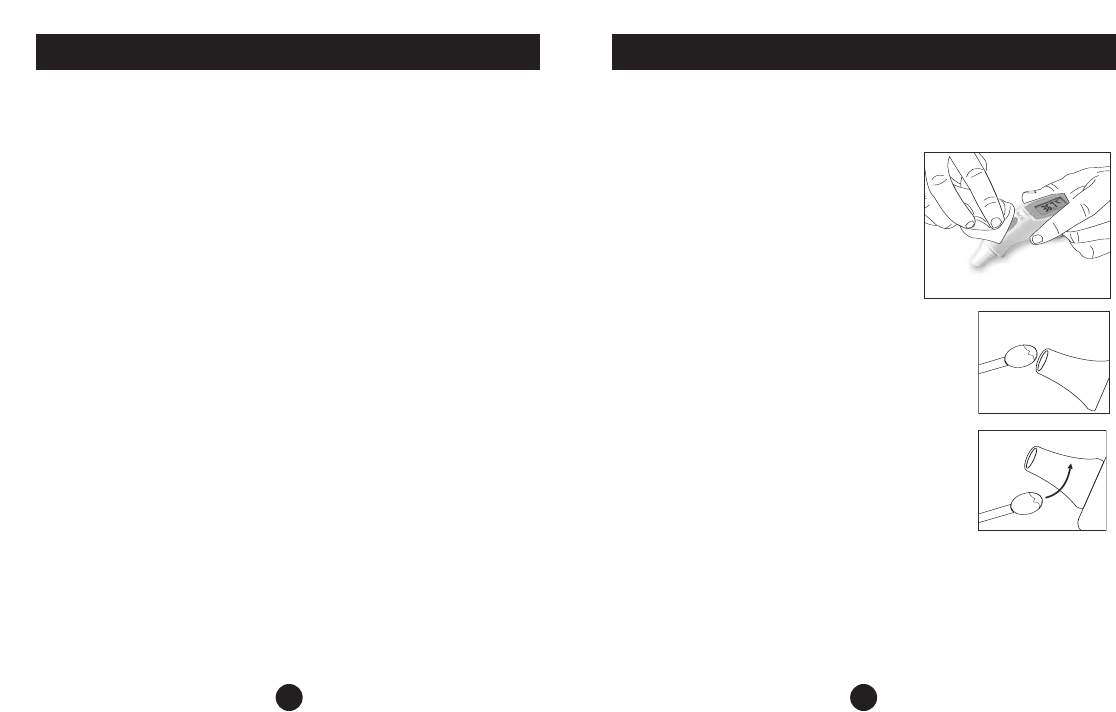
General Care & Important Information
Your Instant Ear Thermometer measures the heat radiated from the eardrum
and the surrounding tissue. This energy is transferred through the probe and
converted into a single temperature value. Although readings taken from the
eardrum (tympanic membrane) can provide the most accurate readings, improp-
er technique can generate lower readings, resulting in a misdiagnosed fever.
1. The thermometer should only be used under the supervision of an adult.
2. Earwax in ear canal may cause an inaccurate reading. Consult your
healthcare professional for proper removal and ear cleaning procedures.
3. Do not use excessive force to insert probe into ear.
4. Do not use if ear canal is wet or if infection is present.
5.
Ear measurements are comparable to oral measurements. Remember
temperatures can vary from 97.0°F to 99.0°F (36.1°C to 37.2°C) and still may
be considered ‘normal’. Time of day, level of activity, exercise and other
activities can attribute to variations in temperature. However, unlike oral
temperatures, factors such as smoking, talking and drinking do not affect
ear measurements
.
6. Do not walk, run or talk during temperature taking.
7. Clean the probe tip before and after each use.
8. Store the unit in the protective case when not in use.
9. Do not touch the probe with fingers.
10. Do not store the unit where it will be exposed to direct sunlight, dust or
humidity. Avoid extreme temperatures.
11. Dropping or subjecting your thermometer to strong shocks should be
avoided.
12. Do not attempt to disassemble the unit, except to replace the battery.
13. If measurement is not attainable, the unit must be replaced.
NOTE: Performance of the device may be degraded if: operated outside of
stated temperature and humidity range; stored outside of stated temperature
and humidity range; thermometer undergoes mechanical shock (drop); patient
temperature is below ambient temperature.
Cleaning and Storage
To ensure accurate measurements, clean the probe lens before and after each
use. Fingerprints and earwax can cause inaccurate readings.
To Clean:
• Use an alcohol swab or a soft cotton swab
moistened with alcohol (70% Isopropyl) to the
thermometer casing and probe lens,
Figs. 1-3. Do not use paper towels. The
fibers may scratch the lens.
• Make sure that liquid does not enter the
interior of the thermometer.
• Never use abrasive cleaning agents, thinners
or gasoline for cleaning.
• Do not immerse into water or other cleaning
liquids.
To Store:
• Remove the battery if the thermometer will not be
used for an extended period of time.
• Store in a sun-free and dust-free, dry area at a
temperature between 68°F – 122°F (20°C – 50°C).
• Protect the thermometer from severe impact or shock.
Keep stored in the protective storage case.
Fig. 1
Fig. 2
Fig. 3
6 7















